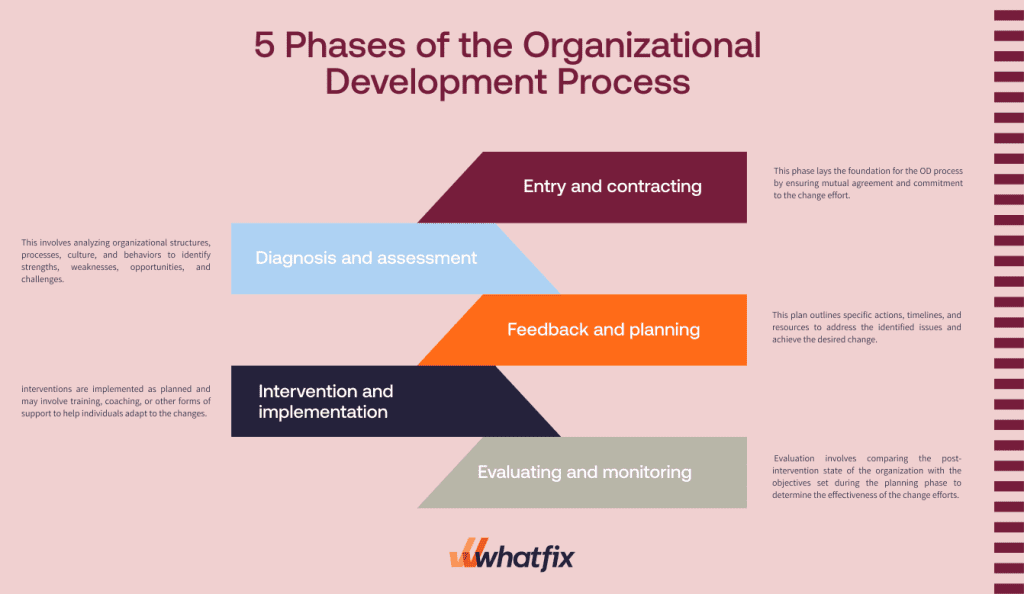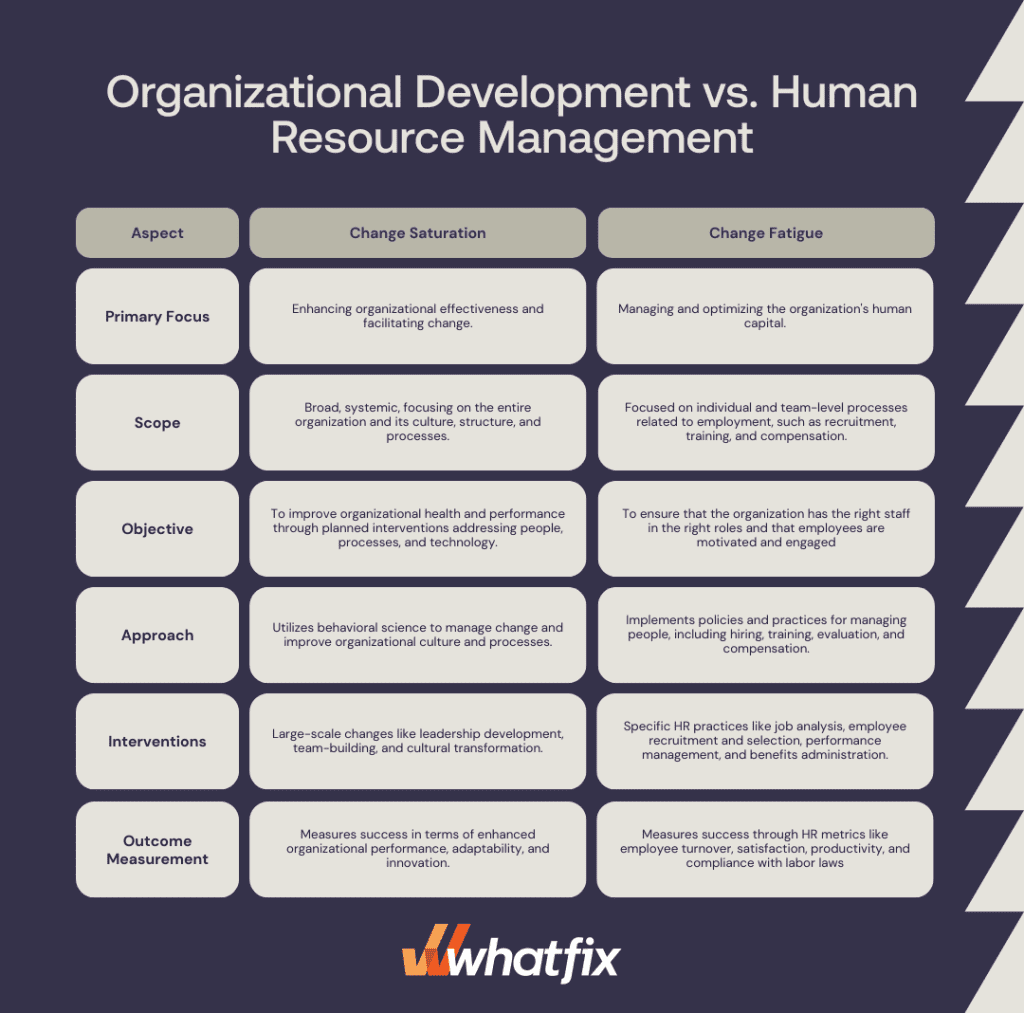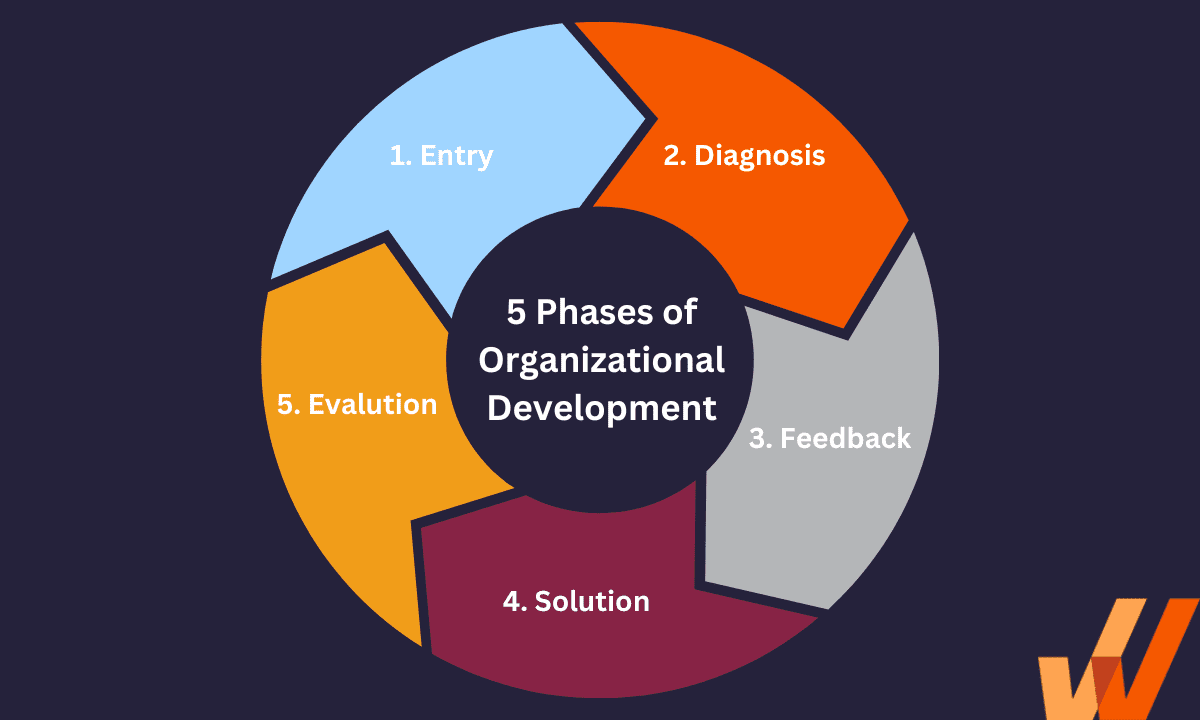
Priyanka Malik


Organizational Development (OD) is at the forefront of transforming businesses into dynamic, efficient, competitive enterprise entities. At its core, OD encompasses a systematic approach to enhance organizational effectiveness and health through planned processes, operations, and culture strategies.
An example of OD can be found at Amazon, which has gained a competitive edge by investing in organizational development. It plans to invest $700 million in OD and retrain a third of its workforce by 2025, helping its workers transition into new, advanced roles by adapting to new technologies, working conditions, business procedures, and overall digital transformation.
There’s a high chance you are already investing in organizational development without a long-term strategy. This guide will help you understand the goals and phases of OD and how you can leverage it for your growth.
Organizational development is an evidence-based scientific approach to help organizations become effective and adaptive to change by developing, improving, and reinforcing strategies, structures, and processes.
Since OD aims at organizational effectiveness, the variable outcomes include financial performance, employee engagement, customer satisfaction, and overall change management.
Let’s discuss some of the most significant goals for organizational development.
85% of employees are disengaged at their workplace, costing $7 trillion in lost productivity, according to Gallup’s State of the Local Workplace. However, the organizational development process focuses on making the workforce more efficient and productive by equipping them with the required skills to succeed in constantly changing markets.
OD also improves communication within the team to align employees with the company’s vision. Once employees feel empowered, they are motivated to give their best and are willing to take more ownership of their work.
Organizational Development aims to cultivate a workplace environment where change is accepted and embraced as a pathway to growth. By fostering a culture that values adaptability, continuous learning, and openness to new ideas, organizations can more effectively respond to market shifts, technological advancements, and internal challenges. This goal involves encouraging employee creativity, implementing flexible processes that can easily adjust to new circumstances, and rewarding employee initiatives.
OD creates an environment where employees feel valued, heard, and connected to the organization’s mission and goals. This is achieved through transparent communication, opportunities for professional growth, recognition programs, and creating a sense of community within the workplace. By investing in employee engagement and satisfaction, organizations can enhance overall performance and foster a positive and supportive workplace culture.
In a competitive marketplace, attracting and retaining top talent is crucial for organizational success. OD plays a key role in shaping policies and practices that make an organization an attractive place to work. This includes offering competitive compensation and benefits, employee development opportunities, a positive work-life balance, and a workplace culture that aligns with the values of the talent it seeks to attract.
Effective communication is the backbone of successful organizational development. OD aims to enhance the flow of information across all levels of the organization, ensuring that employees are informed, engaged, and able to contribute their ideas. Improving communication involves implementing clear, open channels for sharing information, feedback mechanisms allowing employees to voice their thoughts and concerns, and fostering an environment of trust where two-way and constructive communication is two-way. Better communication leads to improved collaboration, faster problem-solving, and a more cohesive organizational culture.
Organizational development is a complex and systematic process. OD practitioners implement the development initiatives in five phases:

This entry phase establishes a relationship between the OD practitioners (internal change agents or external consultants) and the organization. It includes identifying the organization’s needs, setting objectives for the OD intervention, and agreeing on the scope of work. Key activities include clarifying the roles and responsibilities of all parties involved, discussing expectations, and establishing trust. This phase lays the foundation for the OD process by ensuring mutual agreement and commitment to the change effort.
OD practitioners collect data and information to understand the organization’s current state. This involves analyzing organizational structures, processes, culture, and behaviors to identify strengths, weaknesses, opportunities, and challenges. Various tools and methods, such as surveys, interviews, focus groups, and observation, are used to gather insights. The goal is to comprehensively understand the organization’s functioning and the issues that need to be addressed.
This phase aims to create a shared understanding of the diagnosis and to engage stakeholders in discussing the implications. A detailed action plan for OD interventions is developed based on the feedback and insights gained. This plan outlines specific actions, timelines, and resources to address the identified issues and achieve the desired change.
The intervention phase involves putting the planned actions into practice. OD interventions vary widely, including organizational restructuring, team-building activities, leadership development programs, process improvements, or cultural initiatives. The chosen interventions are designed to address specific needs identified during the diagnosis phase. This phase requires careful management to ensure interventions are implemented as planned and may involve training, coaching, or other forms of support to help individuals adapt to the changes.
The final phase focuses on assessing the impact of the OD interventions. Evaluation involves comparing the post-intervention state of the organization with the objectives set during the planning phase to determine the effectiveness of the change efforts. This includes measuring changes in employee satisfaction, productivity, employee turnover rates, or other relevant metrics. Monitoring and gathering feedback from employees during and after the implementation provides insights into the success of the interventions and highlights areas for further improvement.
A noteworthy aspect here is that although OD and HRM (human resource management) are people-centric processes and often used synonymously, they are actually different.
Organizational development is more holistic and strategic, whereas HR is operational and can be considered a subset of OD.

Aspect | Organizational Development (OD) | Human Resource Management (HRM) |
Primary Focus | Enhancing organizational effectiveness and facilitating change. | Managing and optimizing the organization’s human capital. |
Scope | Broad, systemic, focusing on the entire organization and its culture, structure, and processes. | Focused on individual and team-level processes related to employment, such as recruitment, training, and compensation. |
Objective | To improve organizational health and performance through planned interventions addressing people, processes, and technology. | To ensure that the organization has the right staff in the right roles and that employees are motivated and engaged. |
Approach | Utilizes behavioral science to manage change and improve organizational culture and processes. | Implements policies and practices for managing people, including hiring, training, evaluation, and compensation. |
Interventions | Large-scale changes like leadership development, team-building, and cultural transformation. | Specific HR practices like job analysis, employee recruitment and selection, performance management, and benefits administration. |
Outcome Measurement | Measures success in terms of enhanced organizational performance, adaptability, and innovation. | Measures success through HR metrics like employee turnover, satisfaction, productivity, and compliance with labor laws. |
While both OD and HRM aim to improve organizational effectiveness, they do so from different angles and with other tools and methodologies. Collaboration between OD and HRM functions is essential to ensure that organizational changes are effectively implemented and that the workforce is aligned with these changes, contributing to the organization’s overall success.
For example, imagine a company X undergoing a major shift to adopt a remote work model. This change affects how teams communicate, collaborate, and maintain productivity outside a traditional office environment.
OD’s role is to conduct an organizational culture assessment to understand how the shift to remote work impacts team dynamics and employee engagement. OD devises strategies to maintain a cohesive culture and ensure effective communication among remote teams, focusing on change management practices to facilitate this transition smoothly.
HRM’s role is to focus on revising policies to support remote work, including updates to IT security protocols, work-from-home guidelines, and employee wellness programs. HRM also implements training sessions to equip employees with the tools and skills needed for effective remote collaboration and self-management.
Organizational development is pivotal in enhancing HR functions, enabling HR professionals to more effectively manage talent, foster a positive workplace culture, and navigate organizational changes. Here’s how OD supports and promotes key HR functions.
OD initiatives focus on identifying and developing high-potential employees for future leadership roles, aligning closely with HR’s objectives in succession planning. By implementing leadership development programs, OD helps create a pipeline of skilled individuals ready to step into critical roles. These programs include mentorship, training, and stretch assignments that prepare candidates for leadership challenges. This strategic approach secures the organization’s future and aligns with HR’s goal of retaining top talent by providing clear paths for career advancement.
OD specializes in the processes and strategies needed to manage organizational change effectively, from mergers and acquisitions to cultural shifts and process overhauls. By working closely with HR, OD ensures that the human aspects of these changes are addressed, helping to minimize resistance and enhance buy-in from employees at all levels. This collaboration is crucial for maintaining morale and productivity during transitions, with HR implementing OD strategies through communication, employee training, and support programs designed to ease the change process for employees.
OD’s focus on creating positive organizational cultures and improving workplace environments directly contributes to higher levels of employee engagement and well-being. Through initiatives such as employee feedback systems, team-building activities, and development opportunities, OD creates a more engaging and satisfying work experience. HR leverages these initiatives to enhance employee retention, reduce turnover, and attract top talent, recognizing that a supportive and dynamic work environment is key to maintaining a motivated and healthy workforce.
OD encourages data and analytics to inform decision-making processes within the organization, a practice that significantly benefits HR functions. By analyzing data on employee performance, engagement levels, and training outcomes, OD and HR can identify trends, strengths, and areas for improvement. This evidence-based approach enables HR to make more informed decisions regarding hiring, training, and development programs, aligning resources and strategies with the organization’s needs and goals more effectively.

Given the complexity of development initiatives, they often require external interventions for successful change implementation. Organizational development interventions are structured processes that help companies meet specific objectives, enable management, and improve overall organizational functioning.
Typically, you can classify OD interventions as:
Human process interventions are some of the earliest and most effective OD interventions related to interpersonal relations, group, and organizational dynamics.
These programs are related to organizational structure and technological changes. They are highly relevant due to the changing business dynamics.
These programs are related to the organizational structure and technological changes. They are highly relevant due to the changing business dynamics.
These interventions are mainly related to employee engagement, experience, and performance management.
Organizational development interventions play a crucial role in successfully implementing changes that require behavioral change in the organization.
In the world of organizational development, change and growth are the constants that propel organizations forward. However, just as opportunities abound, so do challenges that threaten to undermine progress. Here are some common challenges of organizational development:
One of the primary challenges of organizational development is overcoming resistance to change. Employees may be hesitant to accept new processes, technologies, or organizational structures due to fear of the unknown, a perceived loss of control, or concerns about job security.
Effective change communication is critical to overcoming resistance. Explaining the reasons for change, how it will benefit the organization and its employees, and providing a clear future vision can help alleviate fears. Involving employees in the change management process and offering support, such as training and counseling, can also enhance buy-in and reduce resistance.
The commitment and support of top leadership are vital for driving organizational development initiatives. If leaders fail to demonstrate their commitment, initiatives may lack direction, resources, and the authority to effect change.
Garnering leadership commitment can begin with demonstrating the alignment of OD initiatives with the organization’s strategic goals. Leaders must be involved in planning and informed of progress and outcomes. Showing quick wins and direct benefits to the organization can also help sustain leadership support.
Organizational development initiatives often require significant time, money, and human resources investment. There needs to be more resources and budget constraints to implement these initiatives effectively and achieve the desired outcomes.
To overcome this challenge, prioritize OD initiatives based on their potential impact and alignment with strategic goals to ensure efficient use of resources. Consider phased implementations to spread costs over time and demonstrate ROI from early stages to justify further investment. Leverage in-house resources and capabilities to reduce costs where possible.
The success of OD efforts often hinges on the skills and capabilities of the workforce. Lack of appropriate skills can hinder the implementation and sustainability of change initiatives.
Implement comprehensive talent management and upskill development programs tailored to the needs identified through skills gap analysis exercises. This may include targeted training programs, mentorship, and opportunities for on-the-job learning. Encouraging a culture of continuous learning also helps ensure that the workforce remains adaptable and capable of meeting evolving organizational needs.
Ensuring ongoing commitment and maintaining momentum throughout the organizational development process can be challenging, mainly if initiatives take time to yield tangible results.
To maintain momentum, set clear, achievable milestones and celebrate successes to keep motivation high. Regular communication about progress, challenges, and next steps can help keep the initiatives in everyone’s minds. Additionally, embedding the change into the organization’s culture and practices can help sustain long-term commitment.
Whatfix digital adoption platform stands as a transformative tool in the realm of change management, particularly within organizational development, by enabling employees with contextual in-app guidance and support in the flow of work.
Whatfix significantly reduces the resistance commonly associated with adopting new technologies and processes by offering intuitive, contextual guidance and support embedded directly within enterprise applications. This enables employees to familiarize themselves with new tools and processes faster, as well as maximizes their efficiency through your tech investments.
Whatfix Analytics provides crucial insights into end-user behavior and engagement, enabling organizations to tailor their change strategies for maximum effectiveness. Understand where employees are struggling to adopt new change, where friction in your digital processes is occurring, what features end-users are struggling with, and more.
Moreover, Whatfix’s ability to deliver just-in-time, role-specific training ensures that employees are well-prepared to navigate new systems and feel supported throughout the transition. In essence, Whatfix DAP acts as a catalyst for change, fostering an environment where continuous improvement and development are encouraged and seamlessly integrated into the daily workflow, thereby driving successful organizational development in an ever-evolving business landscape.
Intrigued to learn more about Whatfix? Click here to schedule a free demo with us today!

Thank you for subscribing!